
| Palaeos: |  |
Reptiliomorpha |
| The Vertebrates | Gephyrostegidae |
| Page Back | Unit Home | Unit Dendrogram | Unit References | Taxon Index | Page Next |
| Unit Back | Vertebrates Home | Vertebrate Dendrograms | Vertebrate References | Glossary | Unit Next |
|
Abbreviated Dendrogram
TETRAPODA |--TEMNOSPONDYLI `--+--LEPOSPONDYLI `--REPTILIOMORPHA |--Anthracosauroidea | `--+--Embolomeri | `--Chroniosuchia `--+--Gephyrostegidae `--Batrachosauria |--Seymouriamorpha `--+--Solenodonsaurus `--Cotylosauria |--Diadectomorpha `--AMNIOTA |
Contents
Overview |
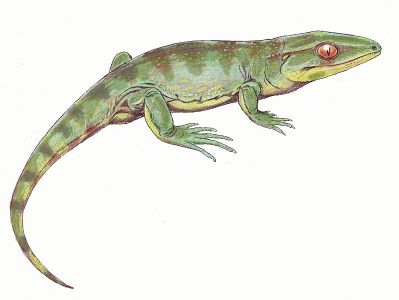 Gephyrostegus bohemicus Jaekel, 1902, a reptile-like amphibian. This animal was moving twoards, but not yet itself the ancestral reptile stage. Life reconstruction, by Dmitry Bogdanov, Wikipedia, GNU Free Documentation/Creative Commons Attribution |
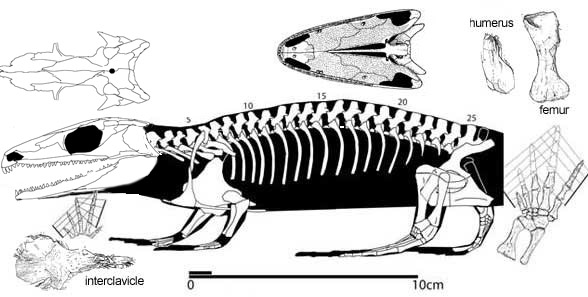
Gephyrostegus is a typical representative of the reptiliomorphs, transitional Permo-Carboniferous forms intermediate between amphibians and reptiles. It was a small animal of generally lizard-like build and presumably habit. It had large eyes and a large number of small, pointed teeth, indicating it was an active insectivorious hunter. The remains have been found in Nyrany, Czech Republic, dating from around 310 million years ago (Moscovian Age - Late Carboniferous) (Jaeckel 1902). It lived millions of years too late to be the actual grand-daddy of the reptiles (and mammals, and birds), but it gives an idea of what such an ancestor (or concestor as Richard Dawkins would say) may have been like. At just 22 cm snout-vent length, Gephyrostegus was one of the smallest (if not the smallest) advanced reptiliomorphans found. (Image, right. Gephyrostegus bohemicus Jaeckel 1902, by David Peters, Reptile evolution)
Gephyrostegus was originally included among the reptiles as a suborder of Cotylosauria (Colbert 1969). A number of traits unite this genus with the reptiles (Crown Amniota) (as distinct from physiological (or cladistic jargon apomorphic) amniotes:
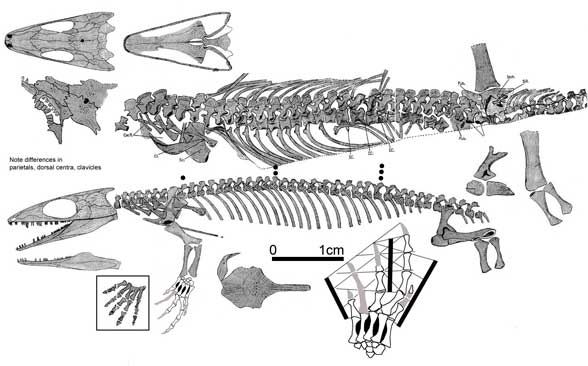
Later it was transferred to the Anthracosauria Carroll 1988; more recently again cladistic analysis has placed it either as sister taxon to (Laurin & Reisz 1999) or above (Clack 2002b , Ruta et al 2003a, Ruta et al 2003b) the embolomeres, but below the seymouriamorphs, lepospondyls, and amniotes. Although it would seem then that the reptile-like traits shared with higher reptiliomorphs and early amniotes evolved through convergence, this may not be the case.
An interesting discovery however were two tiny gephryostegii. Gephyrostegus watsoni (Brough & Brough 1967) (left) was, erected for two smaller, possibly juvenile individuals, was originally named Diplovertebron punctatum (Watson 1926) but was reassigned to Gephyrostegus despite the size difference, which may be due to immaturity or not. If indeed this specimen is immature, it does not appear to be a tadpole, but has the appearance of an adult, as in reptiles. If it is an adult, its size would support the hypothesis of Carroll (1970, 1991), that the first amniote (= reptile) would be tiny. Both specimens retain an intertemporal, which no reptile retains. This may simply be an instance of mosaic evolution. Or it may simply be the case that the tadpoles attained an adult form whilst still very small, and then grew normally.

The two tiny Gephyrostegus specimens have distinct proportions and element shapes sugggestive of a generic distinction hinting taht even at this very early stage of amniote/reptile evolution a wide grade of organization had developed. The upper one is shown with about 36 presacral vertebrae. The lower one probably had fewer than 30. The large Gephyrostegus (above) had but 24.
One reason it is unlikely that Gephyrostegus was a reptile that laid eggs that hatched into minature adults is that the adult Gephyrostegus is still too large to qualify as a proto-amniote, as the size comparison below shows. More importantly it is more primitive in every respect than the seymouriamorphs, which are known to have a tadpole stage.
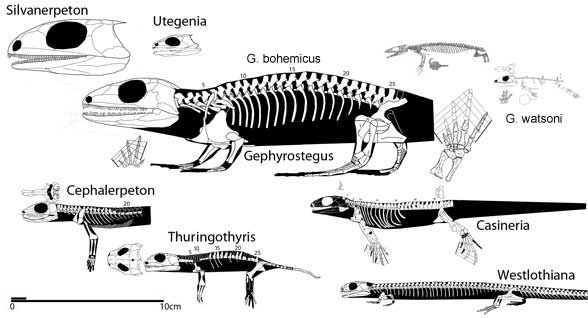 The diagram on the left provides a size comparison of various Stem and crown amniotes. All show a degree of minaturisation which supports Carroll's hypothesis that the first transitional or proto-, amniotes had to be very small, to avoid problems of carbon dioxide build up that would have occurred prior to the development of a complete amniotic membranes. Casineria and Westlothiana, both more derived (advanced, reptile-like) forms than Gephyrostegus, had snout-vent lengths of 10 cm or less, within the size range predicted by Carroll. The same applies to Cephalerpeton and Thuringothyris, traditionally basal eureptiles (Crown Amniotes), although given the phylogenetic uncertainty around some of these early forms it is not possible they had a more basal position, although the small size might simply be a later adaptation, like some extant tiny skinks and geckos for example. Interestingly, little Gephyrostegus and its similar but more primitive cousin Silvanerpeton (an anthracosaur) are giants in comparison, and the baby Gephyrostegii are not much smaller than the adult amniotes and proto-amniotes. So although Gephyrostegus was certainly, like the seymouriamorphs, moving towards the reptilian condition, it had not yet itself beco0me a reptile. MAK111109
The diagram on the left provides a size comparison of various Stem and crown amniotes. All show a degree of minaturisation which supports Carroll's hypothesis that the first transitional or proto-, amniotes had to be very small, to avoid problems of carbon dioxide build up that would have occurred prior to the development of a complete amniotic membranes. Casineria and Westlothiana, both more derived (advanced, reptile-like) forms than Gephyrostegus, had snout-vent lengths of 10 cm or less, within the size range predicted by Carroll. The same applies to Cephalerpeton and Thuringothyris, traditionally basal eureptiles (Crown Amniotes), although given the phylogenetic uncertainty around some of these early forms it is not possible they had a more basal position, although the small size might simply be a later adaptation, like some extant tiny skinks and geckos for example. Interestingly, little Gephyrostegus and its similar but more primitive cousin Silvanerpeton (an anthracosaur) are giants in comparison, and the baby Gephyrostegii are not much smaller than the adult amniotes and proto-amniotes. So although Gephyrostegus was certainly, like the seymouriamorphs, moving towards the reptilian condition, it had not yet itself beco0me a reptile. MAK111109
(Text David Peters 2011 Reptile evolution, Petter B°ckman 110622 Wikipedia, MAK111108. Images David Peters)
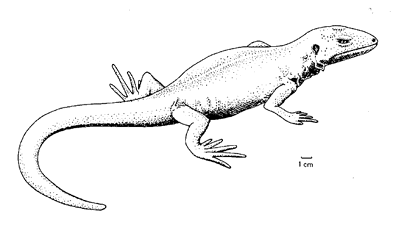 Gephyrostegidae:
Bruktererpeton, Gephyrostegus.
Gephyrostegidae:
Bruktererpeton, Gephyrostegus.
Range: Late Carboniferous (Bashkirian to late Moscovian).
Phylogeny: Reptiliomorpha : Anthracosauroidea + (Batrachosauria + *)
Characters: Smallish; skull and cheek strongly attached; dermal bones marked by pits and grooves; deep otic notch in quadrate (flatly contradicted by [C02] who states that notch is barely present); stapes reduced to narrow rod; 24 vertebrae; pleurocentra large; intercentra small & crescent-shaped; pleurocentrum not fused to neural arches; long limbs; perhaps fully terrestrial. ATW020621 Unlike basal reptiles, the notochord was continuous in Gephyrostegus. An intertemporal bone was present in the skull and a few small palate fangs remained. (David Peters)
Image: Gephyrostegus life reconstruction, iirc from an early edition of Vertebrate Life by F. Harvey Pough MAK111107
Links: Anthracosauria; Biology 356
References: Clack (2002) [C02] ATW020621.
| Page Back | Unit Home | Page Top | Page Next |
checked ATW040109, revised and new page MAK111108